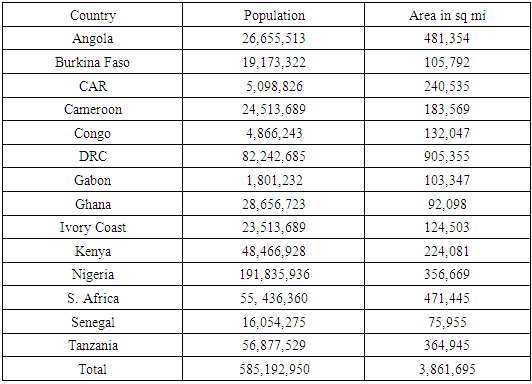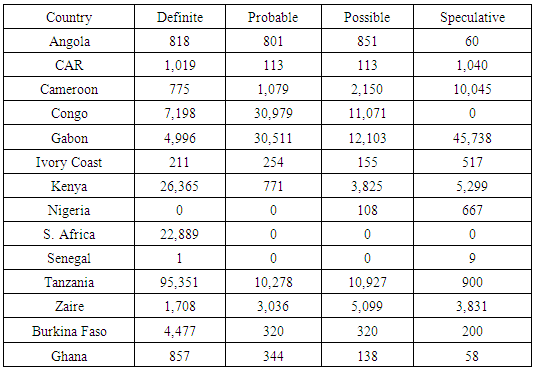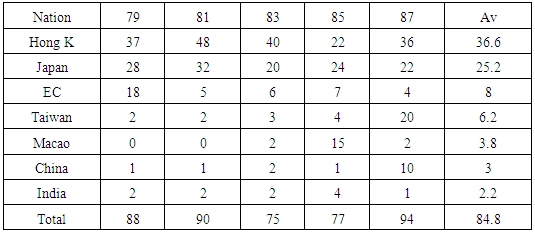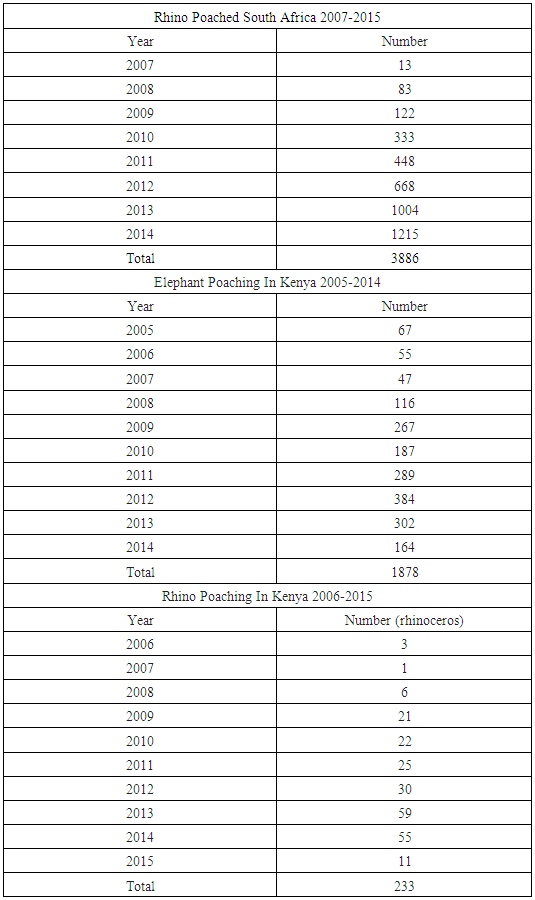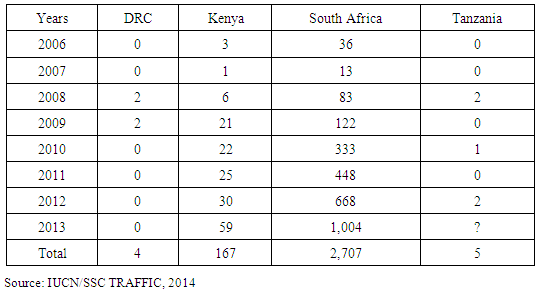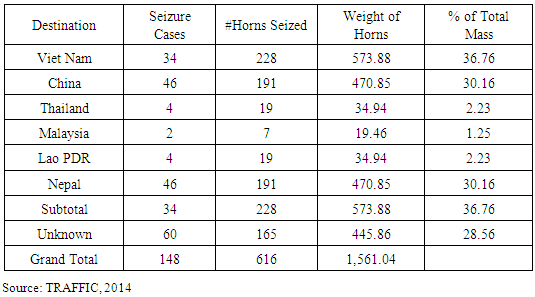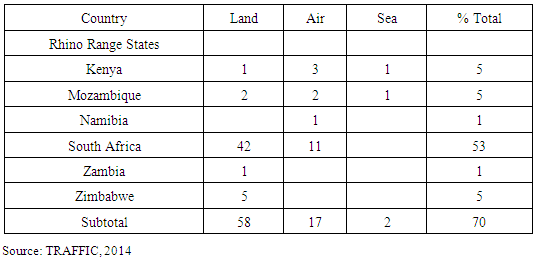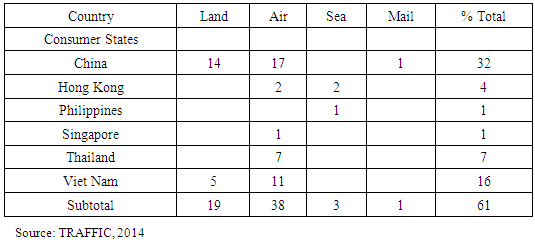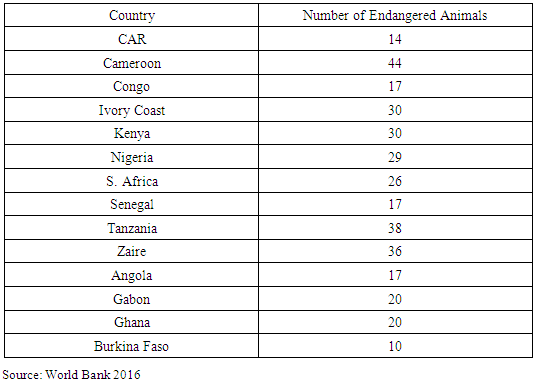-
Paper Information
- Paper Submission
-
Journal Information
- About This Journal
- Editorial Board
- Current Issue
- Archive
- Author Guidelines
- Contact Us
Advances in Life Sciences
p-ISSN: 2163-1387 e-ISSN: 2163-1395
2018; 8(1): 1-25
doi:10.5923/j.als.20180801.01

Assessing the Menace of Illegal Wildlife Trade in the Sub Saharan African Region
E. C. Merem1, Y. Twumasi2, J. Wesley1, P. Isokpehi1, S. Fageir1, M. Crisler1, C. Romorno1, A. Hines3, G. S. Ochai4, S. Leggett3, E. Nwagboso5
1Department of Urban and Regional Planning, Jackson State University, Jackson, MS, USA
2Department of Urban Forestry and Natural Resources, Southern University, Baton Rouge, LA, USA
3Department of Public Policy and Administration, Jackson State University, Jackson, MS, USA
4Department of Health Policy and Administration, Jackson State University, Jackson, MS, USA
5Department of Political Science, Jackson State University, Jackson, MS, USA
Correspondence to: E. C. Merem, Department of Urban and Regional Planning, Jackson State University, Jackson, MS, USA.
| Email: |  |
Copyright © 2018 Scientific & Academic Publishing. All Rights Reserved.
This work is licensed under the Creative Commons Attribution International License (CC BY).
http://creativecommons.org/licenses/by/4.0/

Over the last years, the rapid increase in wildlife trade and the continued disappearance of endangered species has reached a frightening frequency in Africa. While such practices not only undermine sustainability, biodiversity and habitat protection, environmental services provided by natural areas and the species contained therein command infinite value. In the process, the incidence of poaching and illegal wildlife trade area threatens the protection of numerous bird mammal and amphibian species with extinction. In the face of all these, the species at risk lack protection over any part of their ranges due to the costs of management and hosts of socio-economic and physical elements. The heinous nature of these practices comes at the expense of biodiversity protection, global heritage and assets of communities endangered in different countries of Sub Saharan Africa region (SSA). Considering the gravity, illegal wildlife trade has emerged as an international development and environmental issue since it weakens security, rule of law, and any initiatives to boost biodiversity and eradicate acute deprivation. In these nations, various individuals depend on forests, wildlife and fisheries for their survival. When people loose wildlife access and security because of organized criminals involved in the illicit trades, society gives up the critical apparatuses essential in the eradication of impoverishment and sustenance of biodiversity. Just as the disappearance of biodiversity and the presence of violent elements linked to trafficking, reduce the prospects for sustainable development and the stability of environmental systems, including eco-tourism. Protecting wildlife from poaching and illegal trafficking in that setting, helps secure our global heritage in the fight against criminal networks that exploit humans and nature by threatening national security and rule of law. Due to these lapses, there has been a growing interest in highlighting the experience of nations in SSA region known for abundant wildlife and species diversity. Accordingly, this paper assesses the menace to endangered wildlife in the SSA region. With emphasis on the issues, ecological analysis, impacts, the factors influencing it and mitigation efforts, the paper uses a mix scale methodology of descriptive statistics and GIS to analyze the trends spatially. While results point to declines in wildlife species among these countries and spatial diffusion of the trends and the role of several factors, the study recommended several measures ranging from education to the strengthening of policies through a coordinated global action plan to stem the savagery.
Keywords: Illegal Wildlife Trade, Sub Saharan Africa, Region, GIS, Factors, Biodiversity, Endangered Species
Cite this paper: E. C. Merem, Y. Twumasi, J. Wesley, P. Isokpehi, S. Fageir, M. Crisler, C. Romorno, A. Hines, G. S. Ochai, S. Leggett, E. Nwagboso, Assessing the Menace of Illegal Wildlife Trade in the Sub Saharan African Region, Advances in Life Sciences, Vol. 8 No. 1, 2018, pp. 1-25. doi: 10.5923/j.als.20180801.01.
Article Outline
1. Introduction
- Looking at the state of the environment of any region, wildlife plays a vital part in preserving the ecosystem stability. For that, the SSA has full indicators attesting to the immense benefits of different kinds of wildlife in the wellbeing of communities [1, 2]. Yet the ongoing menace posed by the growing tide of illegal wild life trade [3-8], from the SSA region to the consumer nations seems rooted in a historical legacy of barbarity deeply ingrained in the industry currently contributing to the declines in endangered animals with demands in the West and Asia [9]. To that effect, the destruction of African elephant population brought about by the trade showed a drop from 26 million in 1800 to just 1 million in 2016 [9]. The threat posed by these activities has become serious that it has now sparked an avalanche of public paid announcements denouncing the illegal export and trade in the wildlife in the US. Even though it contrasts significantly from the images of periodic large-scale seizures of rhino horns by customs in Asia [10], the notoriety of large urban centers in Sub Saharan African (SSA) nations from Nigeria to Gabon as hubs where public spectacle of ivory occur with impunity exemplifies the regional extent of the tragedy [11-14].Over the last years, the widespread growth in wildlife trade and the persistent vanishing of endangered species has reached an alarming level in SSA [15, 16]. These activities not only undercut sustainability, biodiversity and habitat protection but the growing frequency of poaching and illegal wildlife trade in the area impedes the protection of many mammals from extinction. In Africa, elephants and rhinos face constant butchery by poachers and armed gangs to meet growing demand for their tusks and horns globally and throughout Southeast Asia where elephant ivory merchandize tusks and rhino horns symbolize eminence and raw materials in ethno-medicine [17]. Given the 17,000-20,000 African elephants illicitly killed in 2013 [18, 19] and the slaughter of 1,000 rhinos in South Africa in the same period [20], the SSA region faces very critical situation. While the trend remains severe in the Central Africa region where poaching exceeds the regional average, Vietnam, Thailand and China in the Asian continent are major destinations of rhino horns; where Chinese merchants continue to stack the parts for profitable transactions [21, 22]. As the situation is not different in West Africa, Senegal is believed to have decimated its elephants, and below 550 of them subsist in Nigeria and the Ivory Coast, the bottom line is that these nations have lost much of their elephant population [23]. Considering the extent of the tragedy [24], confining such an inquiry solely to the SSA region overlooks the actual forces fuelling the demands in the first place in the consumer markets. Besides that, the major players driving the ongoing illicit trade encompasses armed bandits in SSA, global crime syndicates, and other elements within consumer nations in Asia that fuel the trade in Ivory and rhino parts with deep frenzy [25-30]. In as much as ivory trade has a major effect in any place where elephants are in abundance, the absence of sustained mitigation efforts in SSA puts wildlife habitats and the species therein at a greater risk more than ever.In 2016, a prohibition on the profitable trade in African elephant’ ivory came into force in the US, but there are concerns over the proposed lifting of moratorium on the importation of wild animals as game trophies from the South African region by the Trump administration. Aside from the dangers, that such ambiguity in policy poses to the protection of endangered wildlife in the SSA zone amidst the demand from consumer nations. Part of the justifications for this study stems from the vanishing speed in staggering numbers [24] of biodiversity and the infiltration of criminal gangs engaged in the illegal trade onto porous habitats to expedite export and the destruction of protected areas [31]. In addition to that, poorly managed sanctuaries and habitats containing mega biodiversity in the SAA region where endangered wildlife are supposed to freely roam around have become epicenters of armed conflicts between state authorities poised to securing these areas and armed poachers bent on illegal trafficking [30]. While such nefarious activities among bandits hamper the paths towards sustainable management of wildlife resources and the stability of environmental systems coupled with the opportunities of nature tourism and use of wildlife for locals [25, 32, 33, 30]. The uncertainty among African leaders towards total ban in illegal wildlife trade, and the reluctance of some western nations in enforcing tougher regulations and global nature of the trade complicates the matter [34, 30]. Yet, safeguarding wildlife resources in the at risk areas of SSA region from the menace of organized poaching and illegal trafficking helps in the preservation of a common global treasure [25]. It is also highly indispensible in the campaign against lawless groups exploiting the perceived vulnerabilities within national borders and wildlife habitats [32]. Notwithstanding the lapses and the regional challenges identified herein, many have now recognized a growing interest in highlighting the dilemma of the nations in SSA as an effective way in raising awareness of the situation and the need to eradicate the menace of illegal wildlife trade [35-39, 21]. However, there is no comprehensive analysis on SSA using a mix scale model of descriptive statistics and the spatial tool of Geographic Information Systems (GIS) in mapping the trends within the region. Elsewhere, there exists body of work under a mix scale model that resonates with the current concerns in the study area. Even though the locus of these enquires centered on tropical forest landscape, change, ecological liabilities, the impacts of resource extractions on the ecosystem and urbanization effects on natural areas containing wild life [40-47]. The expectation is that knowledge of the declines and the menace to wildlife species among the countries in the SSA region and the spatial diffusion of the trends under socio-economic, cultural, physical, and ecological factors will furnish the paths towards a coordinated global action and mitigation measures. Accordingly, this paper assesses the menace to endangered wildlife in SSA. With emphasis on the issues, ecological analysis, impacts, the factors influencing it and mitigation efforts, the paper uses a mix scale methodology of descriptive statistics and GIS to analyze the trends spatially. For the purposes of analysis, the study has five objectives. The first aim focuses on the use of GIS to assess illicit wildlife trade and the use of poached items, while the second objective sets out to design a decision support device for policy makers. The third aim emphasizes the development of a novel system for constructing wildlife protection index. While the fourth objective is to create a framework for biodiversity and wildlife management using mix scale tools of descriptive statistics connected to GIS, the fifth objective tracks local and global forces behind the trade. The paper is divided into five parts. The first section presents the introduction while section two highlights the materials and methods. Section three covers the results with focus on descriptive statistics, GIS mapping, the factors and efforts towards mitigation. In sections, four and five the paper outlines the discussions on the findings followed by concluding remarks and recommendations from the research.
2. Methods and Materials
- The study area of Sub Saharan African (SSA) region refers to the portion of the African continent located entirely or partly within South of the Sahara desert (Figure 1). With a population of over 585,192,950 million in 2016, the SSA region stretches through 3,861,695sq m2 areas across 14 countries from South Africa to Nigeria (Table 1). While the SSA contains a widespread climatic zones or ecozones, both South Africa and the Democratic Republic of Congo in the lower and central parts of the region are referred to as most biodiversity rich or mega diversity nations. In the area, the tropical rainforest of Africa extends through the Southern coast of West Africa with vast presence in Central Africa and West of the great lakes region. Other notable features consist of the Serengeti ecosystem, which spans from Northwestern Tanzania to Southwestern Kenya. With a population growth rate of 2.3%, the SSA region’s population is projected to be 1.5 to 2 billion by 2050 in a setting where 348 identified endangered animals now face serious extinction [48].
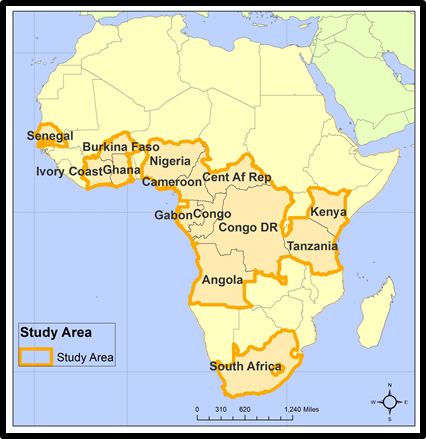 | Figure 1. The Study Area of SSA |
|
2.1. Methods Used
- The paper uses a mix scale approach involving descriptive statistics and secondary data connected to GIS to analyze the menace of illegal wildlife trade in selected Sub Sahara African nations from the central, west and eastern and southern Africa zones. The spatial information for the research was obtained from the International Union for the Conservation of Nature (IUCN), The United Nations Environment Programme. (UNEP), The World Bank Group, The United States Agency for International Development (USAID), The United States Fish and Wild Life services International and The World Wildlife Fund (WWF). Other sources consists of the Center for Biodiversity, South African Department of the Environmental Affairs, TRAFFIC International network, The Endangered Species Protection Unit, South Africa, Kenya Wildlife service, South African National Parks and the Kenyan Wildlife. Overall, some of the wildlife trade export statistics came from ITRGA, the government of South Africa, the Government of Kenya, while the elephant and Rhino poaching and arrests data were obtained from the South African Department of Environmental Affairs. Just as the Center for Biodiversity was instrumental in providing the regional elephant census data for the various countries in the study area, the number of endangered species information emanated through the World Bank Group. While the regional and federal geographic identifier codes of the nations were used to geo-code the info contained in the data sets. This information was processed and analyzed with basic descriptive statistics, and GIS with attention to the temporal-spatial trends at the state and regional levels in the Sub Saharan African Region. The relevant procedures consist of two stages listed below.
2.2. Stage 1: Identification of Variables, Data Gathering and Study Design
- The initial step involves the identification of variables needed to assess illegal wildlife trade in the fifteen selected countries of Sub Saharan Africa. The variables consist of the number of retail outlets, number of ivory items, percentage of ivory items, the elephant and rhino populations, the retail dollar price for elephants and rhino, raw ivory export amount in dollars, the percent of ivory consumption, the weight of ivory and the number of endangered animals. Additional variables encompasses the percent of change, total ivory seizures, number of rhinos illegally killed, number of rhino horns and the weight seized and the percent, the number of rhino and elephant, poached number of rhino and ivory, number of vendors and weight of items, poaching incidents and arrests. Additionally, access to databases that are available within the federal and regional, national archives in the Sub Saharan African region and other agencies quickened the search process. The process continued with the design of data matrices for socio-economic and environmental variables covering the periods from 1979, 1987, 2005, 2009 and 2016. The design of spatial data for the GIS analysis required also the delineation of national and regional boundary lines. With boundary lines unchanged, a common geographic identifier code was assigned to each of the units to ensure analytical coherency.
2.3. Step 2: Data Analysis and GIS Mapping
- In the second stage, descriptive statistics and spatial analysis were employed to transform the original socio-economic and wildlife data into relative measures (percentages/ratios). This process generated the parameters for estimating and assessing the trends, the elephant and rhino population, the percentages and weights of ivory, the number of arrests and seizures, the retail prices of ivory, the percentage of exports and the quantity of poached rhino and elephants and those illegally killed over time in the Sub Saharan African region. This was facilitated by measurements and comparisons of the trends over time. While this approach helps track the levels of consumption, poaching and the prices, the tables highlight the number of wild life killed, biodiversity potentials, and the weights of ivory and rhino items, the percentage of exports to consumer nations, frequency and percentages, number and weights of horns, export volumes, the environmental and economic costs. The remaining steps involve spatial analysis and output (maps-tables-text) covering the study period, using Arc GIS 10.4 and SPSS 20.0. The spatial units of analysis under a mix scale consist of countries, region, and the boundary and locations of wildlife trade. The geographic data for the Sub Saharan African Region which covered its boundaries and states, also includes ecological data of land cover files, and paper and digital maps from 1979-2016. The outputs of the spatial data were mapped and compared from 1979 to 2016 to see the dispersion in illicit elephant and rhino trade as well as the consumption and population levels. With that, part of the outputs of the geographic mapping extends to the killings and poaching and the pricing, and the socio-economic factors fuelling the proliferation of illegal wildlife trade into other continents of the globe through the study area. For more on the mix scale methods, the steps involved and the GIS approach, see Appendix 2-3.
3. The Results
- This portion of the paper presents the results of the descriptive statistics on temporal trends and spatial analysis of endangered wildlife trade with GIS. There is an opening focus on the analysis and distribution of elephant population, export and imports of wildlife, phases of the trade and seizures and impacts in the study area. The remaining segment consists of GIS mapping and spatial analysis, the various factors shaping illegal trade in wildlife along with the current efforts of agencies and nations towards the eradication of the trade in the study area.
3.1. The Distribution of Elephant Populations in 2012
- The elephant population distribution for 2012 under four levels of definite, probable, possible and speculative highlights the relative presence among the countries in the region. Under the definite columns, note that three countries Tanzania, Kenya and South Africa did stand out with highest numbers. Of these nations, Tanzania had about 95,351, Kenya 26,365, and South Africa 22,889 while Congo, Gabon, and Burkina Faso followed up with 7,198, 4,996, and 4,477. While the nearest group of nations Central African Republic (CAR) and Zaire (the Democratic Republic of Congo (DRC) in central Africa wound up with elephant population in the low thousands (1,019-1,708). Another group of countries with huge deficits mostly in West Africa (Angola, Ghana, Burkina Faso, Nigeria, and Ivory Coast) on the other hand accounted for merely hundreds of elephants in 2012 in much of the categories. Other aspects of the distribution trend showed changes regarding the three (probable, possible and speculative) columns with more numbers for Congo and Gabon at over 30,000. Further along these lines comes the remaining elephant populations for two central African nations (Congo and Gabon) estimated at 11,071-12,103 in the possible category. Elsewhere the elephant numbers in 2012 for both Tanzania and Zaire remained somewhat stable at over 10,000-3000 respectively under the listed categories (Table 2). Comparing the elephant populations in the afore mentioned areas to the negligible numbers in other SSA countries like Nigeria as shown in the table, it is apparent that the bulk of available elephants are chiefly concentrated outside of the West African region with many of them solidly in the central, southern and the eastern portions of the study area.
|
3.2. Export and Import of Wildlife Products 1979-1987
- The value of combined export of ivory products showed overwhelming fluctuations among the nations mostly in the Central African region and Eastern and Southern African zone all through 1979-1987 at a yearly average of $23.47 million. Among the select group of exporting countries, the totals began at all-time highs of $30.18-27.96 million in 1979 to 1980. By 1981 through 1984, the trade figures dropped to $24.08-$20.57million and again at $25.01 to $20.79 million dollars. The downward trend continued in 1985 at 21.27 million dollars until an eventual surge to 26.56 million dollars in 1986, which later dropped in the following year (1987) to $14.82 million dollars (Table 2). Of these countries, no single area held on to the top spot consistently since it varied on a year-to-year basis. However, based on the trade figures, Central Africa appears to be the most consistent in 7 of the 9 years. The exceptions being in the opening years of 1979-1980 when neighboring Central African Republic (CAR) and the Democratic Republic of Congo (DRC) Zaire hauled in sizable export revenues ($5.03-611 and 13.2 -$6.06 million) with $13 million plus being the highest price for the DRC ahead of the other nations. During the 1981-1982 fiscal years, the nations of Congo and CAR again stayed very much in the mix under different figures estimated at $13.5-5.74 and $4.2-5.16 million. The other areas with significant ivory trade returns include Kenya and South Africa with export values of $1.95-2.19 to $1.92-3.38 million dollars in the same periods. Further again in1983-1984, CAR still saw huge trade volumes worth $10.8-7.71 million dollars at levels higher than those for Congo do with values at $6.62 and 4.83 million dollars respectively. In 1985 through 1986, a different scenario emerges this time with Tanzania’s ivory exports at $6.7-18.5 million dollars compared to the $5.53-3.8 million for CAR, $2.21-2.53 million in South Africa and the $5.68-.66 in the Congo. By 1987, while the Republic of Congo posted $9.2 million dollars in ivory trade, export revenues waned significantly for some of the others in the order of $.2 7 -.46 million for Congo and Kenya, while South Africa and Tanzania earned $2.92-1.97 million. With that, the average export revenues at the periods of 1979-1987 showed the figures among the first top earners at $5.92-5.40 million dollars for Congo Republic and CAR. The next pair of nations in the same order consists of Tanzania and the Republic of Congo with earnings worth $3.92-3.33 million dollars followed by South Africa and Kenya whose export revenues averaged $2.42-1.73 million dollars respectively [40].Among the individual destinations, for ivory consumption, the dominance of the orient from Hong Kong to India reigns supreme. Under the Far East dominance, the percentage breakdown among the ivory exporting nations rose by 88-90 in the first two years of 1979 through 1981. By 1983-1985, the percentage of ivory use between the consumer nations decreased slightly from 75-77% only to rally again to 94 percent in 1998 at an overall average of 84.8%. From the Table, it is clear that the consumption figures for Hong Kong and Japan not only exceeded the others, but they both had higher averages of 36.6 -25.2% between 1979 to 1987, the European Union or European Commission as a trading block held on to about 8 percentage points as the third highest consumer group. The group of other 4 nations (Taiwan, Macao, China, and India) actively involved in the market averaged about 6.2-3.8 to 3-2.2 percentage points in their share of imported Ivory products. In the period of 1979 through 1981, the top three consumers of ivory and the leading destinations (Hong Kong, Japan and EC) accounted for significant portions (37- 48, 28-32 and18-5%) of the traded merchandize. The same trends holds for 1983-1987 when the consumption levels for both Hong Kong and Japan stood at 40-22% to 20-24% as well as 6-7 % for the EU. All through 1987 fiscal year, as the numbers for the top two, held firm at 36-22% respectively, the EU dropped to single digit values of 4% while Taiwan and China saw increases of 20-10%. The relevant trend worthy of note on the table stems from the double-digit rally (15%) for Macao in 1985 (Table 3).
|
3.3. Initial Phases of the Trade: Poaching and Seizures
- Taking into account the vulnerability of rare faunas in the SSA region, rhino and elephant poaching has seen substantial increases in both Kenya and South Africa all through 2007-2015 and 2006-2015 with the biggest incidents in South Africa than in Kenya. Between the two countries, rhino poaching reached (3,886) 5,061-233 in South Africa and Kenya from 2007-2015 and 2006 -2015 (Table 4). Elephant poaching numbers on the hand began at 1878 from 2005-2014 in Kenya (Table 4); while the numbers for Kruger national Park in South Africa between 1980-2016 were in the neighborhood of 373 based on data from the South African government [40]. At the same time, of the 3,011 cases of rhino poaching incidents that occurred from 2012-2016 in South Africa, about 957 arrests were made [40]. When adjusted to factor other periods, the overall figures for rhino poaching for South Africa from 1990 through December of 2015 stood at 5,103. Furthermore, all through 1990 to 1999, South Africa not only saw 482 cases of confiscations and 746 arrests related to illicit ivory trade, but the seized items weighed 12,701.046 kg with the biggest cases being during the 1992-1993 fiscal years [40].
|
|
|
|
|
3.4. The Impacts of Illegal Wildlife Trade
- In the context of the illegal commerce in wildlife, many nations of the region still faced the dilemma of having many animals on the endangered list in 2016. To that effect, the top three nations (Cameroon, Tanzania, and Zaire) of the SSA zone that ranked higher in endangered animals had 44 to 38 and 36 of the creatures on the list. The nations of the Ivory Coast and Kenya that emerged as the second tier of areas with 30 endangered animals were closely followed by Nigeria and South Africa at 29-26. Five other nations Gabon, Ghana, Congo, Angola and Senegal had 20-17 endangered animals listed nationwide while Burkina Faso and CAR rounded up the list with 10-14 (Table 9).
|
3.5. GIS Mapping and Spatial Analysis
- The map highlights the spatial distribution of large-scale seizures of ivory between 2009, 2010 to 2011 from the lower sides of Africa to the Orient in the global south. From the transnational nature of the activities, the points of focus in SSA centers along the Eastern and Southern portions of the map. While the map rightly highlights the departure, transit and destination nations, note that the three coastal countries of Kenya, Tanzania, and South Africa as covered in the yellow stood out as the major countries of departure. Considering that, the origins of large-scale seizures are mostly in the countries of departure depicted in yellow colors in the SSA region. During those periods, the departure (transit-destination) arrows which are all pointed to the Far East involves a multiplicity of nations made of transit centers (Malaysia, Vietnam, Philippines, and Hong Kong) represented in blue along the transit area of Indian Ocean and the final destination routes in the Far East nations of Thailand and China represented in pink. Another interesting observation during the large-scale seizures of ivory from the map during the periods of 2009, 2010, and 2011, is that the volume of activities leading to the seizures held firm all those years (Figure 2). The same thing applies to the versatility and complex nature of the illegal ivory trafficking routes. The networks, which extends from the entire SSA zone to the far southeast corner of the transition point towards the Orient (Figure 3). Taking a cue from the legends in the map one notices that the dispersion of elephant ranges in blue extends through the hot spots mainly in the Southern Africa region while the land routes permeates the SSA zone up and down to as far back as the North African corner. With that came the exit points by sea and shipping ports outlets depicted in red black dots with extensive networks across coastlines alongside domestic markets firmly operating in capital centers from west, central, and east zones to the southern region denoted in the big red-black dot icon (Figure 3).Along those lines, in the span of 16 year period from 2000-2016 as the map shows, ivory trafficking routes from the SSA source region in the pink-red to transit points in black and the final destinations in the Asian continent assumed a much wider network. It not only broadened but in that period, the trafficking path extended further beyond the shores of SSA to the Far East, and into the Persian Gulf region. Based on the map, many West African nations such as Nigeria and Togo stood out as major trafficking points while the Central African countries of DRC and the Republic of Cameroun remained the sources of trafficked ivory with the DNA pointing to the surrounding states all through to Gabon, Congo and the Central African Republic as the origins. The other source and transit points extends deeper also into East and South African countries comprising of Tanzania, Kenya, South Africa, Mozambique and Zambia and the island nation of Zanzibar as the key transit area. Aside from the DNA source nations evident in the Southern African area, note also the visible presence of other transit nations in the Asian market made up of Laos, Vietnam, Malaysia, Singapore, Philippines, and Thailand with Japan China, and Hong Kong represented in dark orange as the final destinations and consumer markets in the Orient (Figure 4).The location of known and possible ranges of elephants in the region represented in blue and light yellow since 2007, pinpoints wildlife habitats at the center of deadly armed battles where heavy casualties are common (Figure 5-6). This affirms the dangers which areas surrounded by the major flash points of different conflicts dating back to 2010-2012 pose to elephant populations and citizens nearby (Figure 5-6). With these conflicts involving organized battles of rebel attacks as well as violence directed against civilians denoted in the green, red dots and purple spots symbolizing the locus of casualties, riots, protests, violence and battles. Clearly, no part of the elephant ranges in the study area seemed safe from the outbreak of conflicts and protests. Beginning in the West Africa region, the network of troubled areas clustered all over Nigeria in red and purple are not only serious threats, but also they are not far from Cameroun in the central region. There are also considerable exposure to danger among the elephant habitats spread across Burkina Faso, Benin Republic, Ivory Coast, and Ghana. Aside from patches of armed rebel outlets nearby along the Central Africa nations (of Congo, Democratic Republic of Congo, Congo Gabon), the neighboring nations of Kenya and Tanzania and Uganda in East Africa seemed fully vulnerable to large scale conflicts emanating from the North East African region nations of Sudan, South Sudan and Somalia as well (Figure 5-6). Moving further deep into the South African region, there are still danger zones that could threaten Angola and South Africa as shown in the Map. Another dangerous twist to discern from the maps involves the rapid dispersion of areas with more than fifty causalities as well as deaths from major battles within the vicinity of elephant habitats across the countries between 2010-2012 (Figure 6) (Figure 5-6).Pertaining to the monitoring of the percentage of illegal killings of elephants in the 2007 fiscal year with known and possible ranges around the regions of the SSA, aside from a visible cluster of areas where the investigations of such cases are ongoing. See that the monitoring of illegal slaughter of the largest mammal represented in pink are scattered under other categories across the countries. Of these, West Africa had some presence most notably in the Burkina Faso, Republic of Benin, Togo, and the Ghana axis with a few patches evident along the westerly portions of the area from Senegal to Ivory Coast and slightly in Nigeria. Looking further towards the middle of the SSA region on the map there appears a vast array of areas where the massacre of elephants remains visible. These killing sites consists of those diffused around the central African nations of the Republic of Cameroun, the Central African republic, and the Democratic Republic of Congo, Gabon, and Congo with few other clusters in north east Africa. The trends in the illegal killings of elephants is manifested further with a broad spread deep into the Eastern corner of SSA made up of Tanzania, and Kenya with more activities evident in the South African region in 2007 (Figure 7). Consistent with the elephant range killings in SSA, are the percentage distribution of the extent of the savagery captured under different numeric components in both upper and lower scales representing the regions (west, central, eastern, and southern Africa) in various colors from green to orange (Figure 7). In the context of illegally killed elephants in 2011, in the various areas of SSA from West Africa, Central Africa, Eastern and Southern Africa, it is clear that the areas where illegal killings of elephants had occurred outpaced the level of natural mortality in the designated points. While the South African region shares a mix of natural deaths, evidence of that in the Republic of South Africa in the lower end of the map indicates the country stayed in the mix. Moving further out of the Southern region to the upper most and central areas of SSA along the East and Central Africa region, one finds a vast concentration of countries with a mix of illegal killings and natural deaths of elephants prominent along the nations of Tanzania and Kenya in East Africa. The additional instances of such incidents are spread across the central Africa zone in the Democratic Republic of Congo, Congo and the Central African Republic. Further proof of the percentage of illegal killings shows they are also manifested in Nigeria, Burkina Faso, Benin republic, and the western portion of SSA (Figure 8). Judging from the legends under orange and blue colors as displayed on the map, poaching incidents targeting African elephant range population fluctuated with recurrent skid during the periods of 1979-2007. From an initial estimate of 1.3 million elephant population in place during the 1979 fiscal year mostly in central and east Africa, the numbers dropped significantly in the hundreds of thousands (472,500-690,000) with much of that scattered all over the continent in 2007. With the disappearance of elephant population in that manner precipitated by protracted and organized nature of poaching in SSA from West, Central Eastern and Southern areas of Africa (Figure 9). The plundering of large mammals at that scale all through 1979-2007 in the SSA region not only created a senseless mayhem, but it decimated the range elephant populations across time and space. On the demographic side of things, the ongoing analysis covers three main areas germane to wildlife management and the current threats in the SSA. The three areas include African elephant range and population density, population distribution and population distribution by country. The concentration of elephant range and population density as presented under multiple classes for 2007 per 100 km2 appear fully concentrated along the South African region. Countries in the region made up of Zimbabwe and parts of Botswana with Namibia held on to sizable elephant population ranging in the order of 300-520 to 200-300 (represented in blue and red) more than the nations in other areas (Figure 10). Elsewhere, the population distribution of elephants highlight multiple dispersion of the animals on various scales beginning with 0-100 in yellow to the light red (of 1000-5000 and 5000-10,000) spread across the SSA region. Among the components displayed on the map, the largest scales of 10,000-50,000 were evident in the Congo and Gabon areas in Central Africa while the Tanzania-Zimbabwe axis in East and South Africa side of the scale held firm in the concentration of elephant population classified under the 50,000-80,000 category (Figure 11). A further look on the spatial distribution of elephant population map indicates dual appraisal levels identified as minimum and maximum. The dispersion patterns seemed characterized by notable presence along the countries of Kenya, Tanzania, and Botswana, Mozambique in East and Central Africa and South Africa. Additional network of clusters in elephant populations in the SSA zone showed a gradual spread along the central African nations of Gabon, Congo, and Democratic republic of Congo. From there, note also that the distribution configurations in the Central, Eastern and South Africa regions outpaced the levels in the Western areas of SSA where the scales remained lower when compared to the other zones of the study area as previously mentioned (Figure 12). The problem remains compounded by the emergence of East and Central African regions as areas with the most exposure to animal endangerment and extinction in 2016 than the other zones in the Sub Saharan African region. Such portrayal of the mid-African area surpassed the West African zone where animal species endangerment numbers stayed sizable in a couple of nations while the trends in the South African region of Angola and South Africa paled in comparison to the rest of the SSA region (Figure 13).
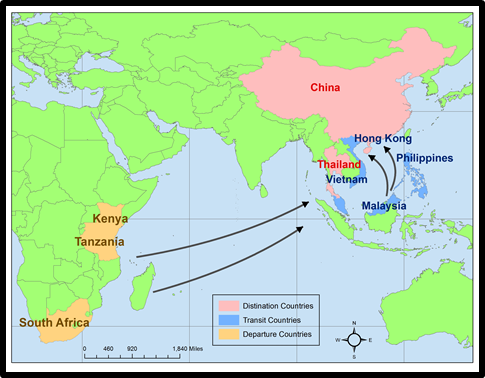 | Figure 2. Map of Large Scale Ivory Seizure, 2009-2011 |
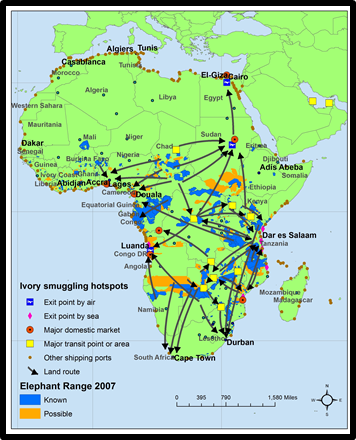 | Figure 3. The Illicit Ivory Smuggling Routes |
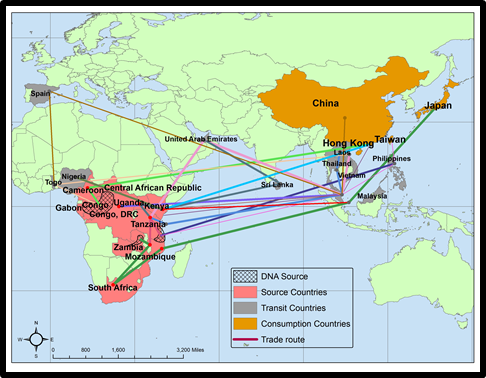 | Figure 4. Ivory Trafficking Routes 2000-2016 |
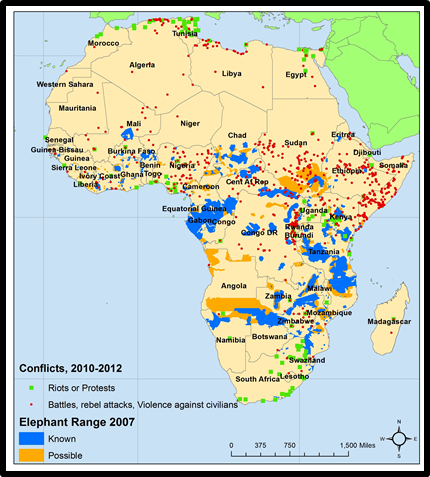 | Figure 5. Sites of SSA Conflicts and Elephant Range |
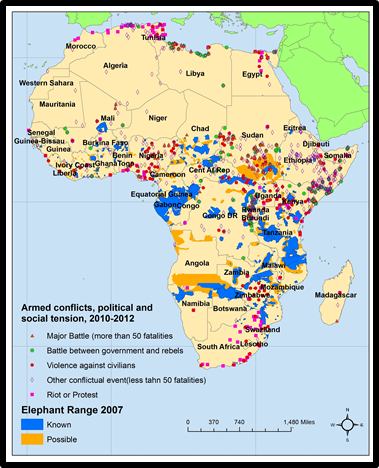 | Figure 6. Elephants Endangered by Conflicts |
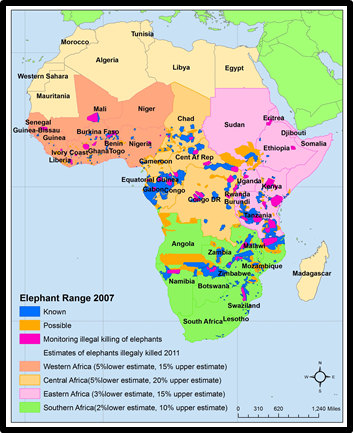 | Figure 7. Percentage of Illegally Killed Elephants |
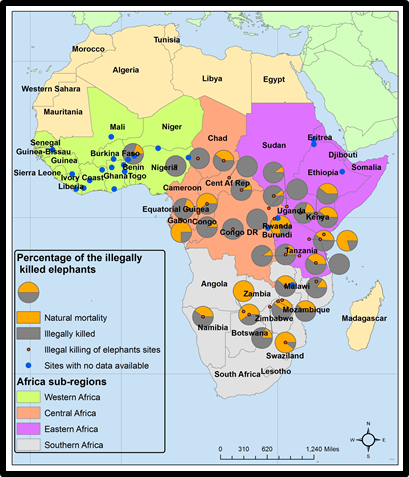 | Figure 8. Estimates of Illegally Killed Elephants 2011 |
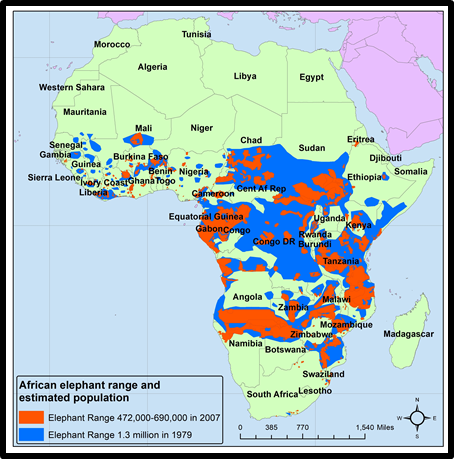 | Figure 9. Elephant Population Range 1979-2007 |
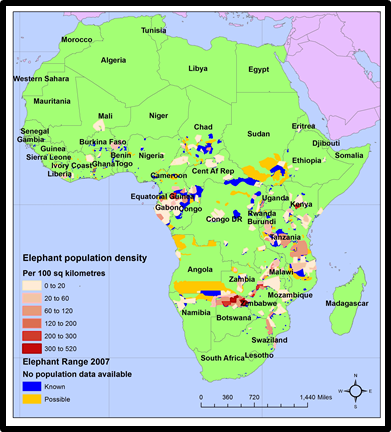 | Figure 10. Elephant Range Population Density |
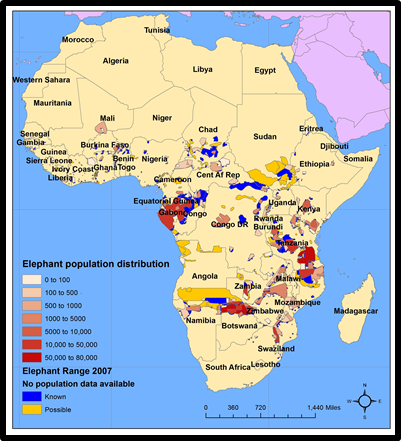 | Figure 11. Elephant Range and Population Distribution |
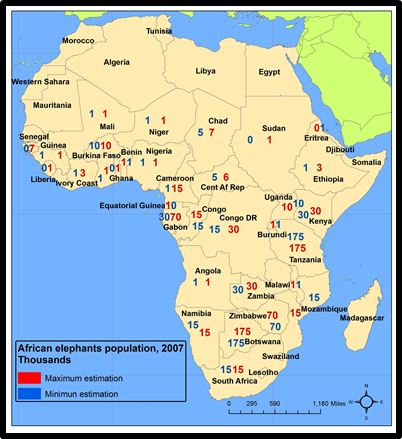 | Figure 12. Elephant Population by Nations, 2007 |
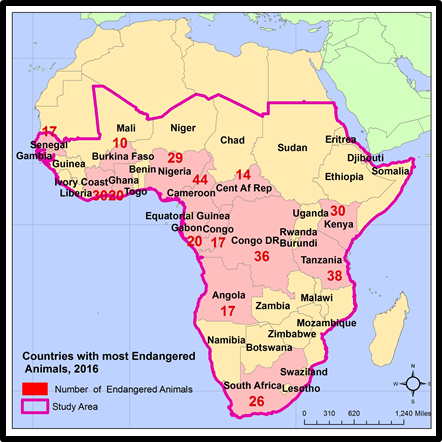 | Figure 13. Spatial Distribution of Animal Extinction In SSA |
3.6. Factors Linked To Illegal Wildlife Trade in SSA Region
- The present wave of illegal wildlife trade in the Sub Saharan African region does not occur in isolation. It is attributed to a set of economic, socio-cultural, growth, land use and complex factors rooted in instability and changing climate. These factors are described concisely in this section of the paper one by one.
3.6.1. Flourishing Economic Hubs as Market Conduits
- In the study area of SSA, the trade in illegal trade operates as an essential component of local economies. For that, the global trade in wildlife products runs through extensive network of markets across SSA as conduits. In these areas, transactions involving elephant parts occur under open display of the products by vendors. In that setting, willing buyers patronize the distributors just like any other activities in everyday markets where exchange and distribution occur among buyers and sellers. Of great importance in the marketability of the ivory parts is that the region has had vast webs of supply outlets in operations since the 1990s and the 2000s (2002-2017) in various regions of the sub-continent stretching from West Africa, the Central to the Southern African areas. With the major hubs clustered in such cities like Lagos, Nigeria, Abijan Ivory Coast, Dakar Senegal, and Bangui in Central Africa to Durban South Africa in the 1990s and the late 2000s. In the opening decades of the 21st century based on available data, among the SSA zones, the West African region boosts of a pair of major nations and cities where ivory trade occur on a daily basis. Given the volume of the trade, ivory commodity dealings operate efficiently in Lagos, Abidjan and Dakar as main points for supply. While in the West African region, the biggest volumes of ivory trade in Lagos occur at the Ilasan Art Market along the Jakande Estates and a number of luxury hotels. Numerous sections of Abidjan are also in the forefront in such places like the Plateau, in Cocody and in Zone 4 as well as the shops in the Koumassi suburb followed by similar outlets in Dakar. On the South African region where Luanda, in Angola ranks high as another destination for ivory trade, the Benfica market offers numerous pricey retail items to ivory consumers regularly. With ivory markets characterized by retail stores, malls and boutiques where carvers hone their trade in central Africa, in the late 1990s in the DRC, 7,700- 10,400 kg per month of Ivory went through the city of Kinshasa. In Libreville, Gabon, stalls and jewelry boutiques participate in transactions involving various sizes of ivory in craft centers while in Cameron, the cities of Douala and Yaunde also boost of major outlets. With the nature of these activities in the region, the cities in the individual nations as conduits still serve the consumer destinations operating in Asia, Europe and other areas.
3.6.2. Socio-Cultural Factors and Ineffective Policies
- The trade in illegal flora and fauna would not be flourishing intensively if not for socio-cultural elements and infective policies. Because of its availability and cultural demands, poverty and deprivations, the growing incidence of Illegal wildlife trade hauls in billions of dollars [54, 37]. For that, the obsession with the illegal traffic in wildlife products serves the life style of individuals and communities as enshrined in their socio-cultural norms. Notwithstanding the prohibited marketing of live animals and products emanating from them, the place of culture and traditions still trumps the laws and policies as wildlife is merchandized as skins, leather materials, foodstuff or ethno medicine and; as pets, and in several additional forms [17, 36]. The trade in wildlife business also extends to the illicit logging of protected forest areas to sustain the needs for glamorous woods for the decoration of opulent homes in the Orient and the plundering of elephant populations to drive up the demand for ivory products. Just as the global outcry over the widespread poaching of African rhinoceros has intensified, the request for their horns surged repeatedly in the Asian continent for socio-cultural practices. Because of those needs, deep in many areas of the Asian continent, rhino horn serves as an integral part of ethno medicine delivery systems based on its use as remedy in the treatment of different health disorders. Aside from the lack of empirical proof to back such assertions, the intense increase in poaching to sustain local demands in Asia is driving rhinos near the verge of disappearance. Whereas the point in all these is that poaching and smuggling of ivory tusk and rhino partly occur to finance the life styles and socio-cultural practices of other people miles away from the decimated elephant ranges in the SSA. The insidious nature of Illegal wildlife trade is so unsustainable a venture that it is associated with the destruction of wild populations of flora and faunal species and accelerating the extinction of endangered creatures. In the process, endangered flora and fauna species is frequently the sole object of wildlife criminality due to their uncommonness and bigger monetary worth. By so doing, the practice of illegal wildlife trade negatively affects a nation’s natural resources base by diminishing its potentials and ability of local citizens to profit from the benefits that accrues ecotourism. Another dimension on the policy side stems from the role of EU nations in not doing much to curb the heinous practices and the divisive stance and reluctance of African nations in containing the sale of endangered animals by oversee patrons who flock these nations as Safari tourists given the monetary benefits [55]. If the regulations in place were effective enough in the SSA and the consumer nations all these years, the lust for illegal wildlife products would at least be curbed to some degree, hence the problem.
3.6.3. The Rise in Human Population in the Region
- Africa is home to one of the globes rapidly increasing human populations at growth rates higher than other continents, and the size of elephant populations exceed available habitats in a place where people compete for space with biodiversity [56, 36]. Seeing that the forest and Savannah types of elephants usually avoid humans, as a result, large human population and densities diminish the size of existing territory for elephants not only by transforming land for human settlements, but also incidentally by erecting fences to land areas available to elephant populations. In such settings, it has been projected that a density of 15 people per square kilometers, signifying about 40-50 percent of changes in human land use, embody the threshold upon which elephants varnish. Furthermore, in 2009, when Africa’s overall population reached 1 billion citizens, the growth rate at most countries therein exceeded 2 percent and at the level, by 2050, the continent population will crack the 1.9 billion mark. The land use requirements to house such number of inhabitants will severely diminish available habitats for elephants. The spatial dispersal of such teeming human population remains disturbing considering that the bulk of the surviving elephants occur adjacent to protected areas (national parks, wildlife reserves, and world heritage sites) in Central Africa, and they provide secure refuge from pressures emanating through competing land uses, poaching, and armed warfare. Since human settlements increases within lands located around protected areas in some nations because of abundant natural and monetary resources, which protected areas offer. Population pressures in places adjacent to protected habitats raises the probability of illicit timber and mineral extraction, poaching, and hunting, fire frequency, human-wildlife conflicts and destruction to biodiversity and species extermination within them. Aside from openly threatening elephants and habitats within protected areas, built up areas near them generate a sphere of disruption that probably insulates elephants and other animals from adjacent ranges and thus exposes them for poaching and illegal trafficking.
3.6.4. Land Use Changes, Barriers to Movement and Development
- The pace of natural resources extraction activities and the associated network of operating infrastructure continually impede the survival of forest and savannah elephants in West and Central Africa. In West Africa where human population increases, highway construction, agriculture and the logging sector stayed rife, the degradation of elephant habitats grew. In light of that, by the mid-1980s, elephants were pushed out of 93 percent of their range. Central Africa’s forest, mostly in the Congo Basin, holds 95 percent of the remaining known and possible elephant range that are now at risk of suffering a similar fate. Given the pace of industrial development in these forests because of their vast quantities of natural resources, the rainforests in West and Eastern Africa have been reduced to 8 to 12% of their former size, while Central Africa’s forests still maintain about 60% of their range. Along with human population growth, industrial logging, slash and burn farming, road and infrastructural expansion and over hunting threaten to degrade the forests and significantly reduce available habitat for forest elephants and exacerbate hunting pressures already ravaging them. Road construction to facilitate the activities of logging industries is perhaps the biggest dangers to elephants and their habitats [36]. In Central Africa where over 30% of the forest have logging concessions only 12% is protected and the roads do splinter adjoining habitats into smaller, isolated patches resulting in serious vulnerabilities with more roads enabling access to further resource extraction and settlement. These roads also open up the forest to bush meat hunters and ivory poachers, which is already a significant threat to elephant population in the region. With 30% of the total forested area estimated to be experiencing increased hunting pressures due to road development and the creation of local markets. Lingering over hunting and forest loss in West Africa led to collapse in the elephant populations there. Because human-elephants interactions breed conflict in the process, crop-raiding incidents involving elephants pits them against humans with potential butchery and displacement. Just as habitats loss has diminished elephant range since the 1970s, in several places where high human and elephant population interact, the presence of elephants are viewed as nuisance notwithstanding their endangered status [56].
3.6.5. War, Political Instability and Climate Change
- There is well-documented evidence that war and other forms of civil conflicts and political instability and climate change have a negative impact on not only humans, but wild life as well, especially in Africa. Elephants have suffered because of a number of civil conflicts in Africa, and threatened by political instability leading to future conflicts. Elephants may be harmed due to civil conflicts through a number of ways. Displaced people seeking refuge in remote areas, reduce habitat for elephants, whereas wildlife products such as ivory are sold for food, arms, and ammunition. Militias themselves rely on easily extractable natural resources to fund their activities. Elephant casualties can also occur as direct result of war activities, such as the accidental explosions of land mines. All of these have occurred with the collapse of wildlife conservation of national parks and other protected areas. Unfortunately, 25 nations in many regions of Africa fought civil wars in the last 50 years that resulted in elephant population declines. In fact, during the civil war in the DRC from 1995-2006, elephant populations declined. The direct impact of conflicts on elephants was witnessed in the Southern African zone where Angola’s civil war that displaced over 4 million people led to the slaughter of 100,000 elephants in rebel –controlled territories. The rebel army sold elephant ivory and rhino horns to pay for arms and used the animals as food. Global climate change is happening at an unprecedented rate and threatens numerous species and their habitats. Average temperatures in Africa are projected to rise at least 2°C by the end of the century with major changes to the ecosystem. Even at that, many remain unknown on how Africa and its elephants will be impacted by climate change, but there is a consensus that water availability will decrease, leading to competition among people and wildlife for this resource. Elephants are considered highly vulnerable to climate changes due to their need for 150-300 liters of water a day. Drought not only causes direct mortality in elephants, but a single year drought may affect populations for 2-3 years afterwards. Drought in Tsavo in the early 1970s killed 6,000 to 9,000 elephants. This same drought reduced the surface water of Lake Chad in West Africa by 70%, drove herds south into Central African Republic protected areas for water, and pastures while competing with elephants and reducing the amount of available habitat to them. Thus, climate variability as one of the primary drivers for land use change and wildlife trade, fuels water stress that pushes people and cattle further into the range elephants. This escalates human-elephant conflicts with range reduction and increased poaching.
3.7. Efforts through Various Partnerships
- Aside from the factors fuelling illegal wildlife trade in the SSA region, numerous measures are now being taken among the nations and multilateral agencies with set objectives and formal schemes to meet the current threats to endangered wildlife in the study area. For more on the initiatives of the different agencies and actors to increase the protection of endangered habitats and stem the tide of illicit trade from the departure, transit and destination points of wildlife products, see Appendix 1.
4. Discussion
- The paper assessed the extent and form of the menace of illegal wildlife trade that is endangering rare flora and fauna and biodiversity in the Sub Saharan African region with emphasis on the issues, ecological analysis, impacts, the factors influencing it and mitigation efforts of various agencies. Essentially noteworthy are the connections of various socio-economic, physical and ecological elements involving weak policies and thriving markets in major cities as part of the causes of the problem. Other factors encompass the outbreak of wars, armed groups, politics, climate change, land use, population, cultural practices and norms. To undertake the enquiry, the study used a mix scale approach connected to GIS and descriptive statistics and secondary information procured at the national and regional level. Aside from the widespread ecozones of the region from South Africa to the Democratic Republic of Congo in the lower and central parts of the region often referred to as the most biodiversity rich or mega diversity nations. Presently, hundreds of rare flora and faunal species are listed as endangered across the SSA region. For that, poaching increased significantly in the last two decades during the period of frenzied legal ivory trade from 1979 to 1989. At that time, Africa’s elephant population declined from 1.3 million to 600,000 from 2000 to 2013 as the quantity of huge scale ivory transaction gradually surged in terms of supplies and the bulk of ivory unlawfully exported. Even at that, in the period of 1979 through 1981, the leading destinations of ivory supplies and the consumed items remained nations in the Orient (Hong Kong, Japan and the EC) that used up significant portions (37- 48, 28-32 and 18-5%) of the traded merchandize. The same trends holds for 1983-1987 as consumption levels for both Hong Kong and Japan reached double-digit rates with the EU at lower levels. Within the same time, Taiwan and China saw increases of 20-10%. From the recognizable evidence of the risks posed to wildlife populations obvious through the distribution of changes, on three categories tagged probable, possible and speculative. Two central African nations outpaced the others in the region. Among the nations in the region only two countries, most notably Congo and Gabon had 30,000 of their respective elephant populations identified as probable. The same pattern of distribution holds in the possible category where the remaining elephant populations for both Congo and Gabon again stood at 11,071-12,103 respectively. In light of that, the total export of ivory goods revealed visible variations amongst the nations especially in the Central, Eastern and Southern African zone all through 1979-1987 at an annual average of $23.47 million. Among the select group of exporting countries, the totals started at very high levels of $30.18-27.96 millions in 1979 to 1980. Between 1981 through 1984, the traded items fell by $24.08 -$20.57million and again at $25.01 to $20.79 million dollars. Notwithstanding the volume of export trade that involved elephant parts therein, the complete figures for rhino poaching in South Africa from 1990 through December of 2015 reached a staggering level of 5,103. From 1990 to 1999, South Africa not only accounted for hundreds of seizures and detentions connected to illegitimate ivory trade, but the seized objects weighed 12,701.046 kg with the largest hauls in 1992-1993. Further, into the years (in 2009-2012) Kenya also experienced rhino slayings with minor surges. The spatial scrutiny of the trends by means of GIS mapping, underscored the geographic diffusion of the intercontinental seizures in smuggled ivory, the smuggling routes and the conflict zones leading to the massacre of elephants and wildlife. Aside from the spatial display of the various locations of illegal killings and the proportions of natural deaths, the GIS mapping pinpointed clusters of areas with concentration of elephant range and population density and the population distribution of elephants throughout the SSA region over time. Contained in that category are the geographic dispersion of ivory seizure routes in SSA centered along the Eastern and Southern portions of the region made up of three coastal points of departure in Kenya, Tanzania and South Africa and the transit centers from Malaysia Hong Kong and the final destinations of Thailand and China. With the regional breakdown of the spatial analysis, pointing to other ivory trafficking routes centered at West African nations (Nigeria and Togo), the sources of trafficked ivory and the DNA seemed more concentrated among a handful of Central African countries. Of great relevance in the GIS mapping is the vast presence of the conflict zones threatening wildlife habitats through illegal killings and the concentration of elephant population density spread along nations of SSA especially in the east, central and southern zones. The other significance of the analysis comes from the capability of GIS mapping in pinpointing the threats to elephants with illegal killing sites diffused more throughout central and East Africa coupled with the identification of West Africa as the zone with lesser number of elephants. On the hand, both East and Central Africa emerged as the zones with more exposures to animal extinction.Seeing that illegal wildlife trade issues outlined herein did not occur in a vacuum, the paper identified several factors fuelling it. The factors embody the flourishing markets, socio-cultural habits and weak policies, teeming population, land use changes and barriers to movement, war political instability and climatic variability. With the dangers posed by recurrent disappearance of endangered fauna and illegal wildlife trade in the region, the paper identified ongoing efforts towards containment of the menace. The highlighted efforts involves global course of actions, international partnerships, multilateral agency initiatives as well as protected area plans. With that, the challenges posed by illegal wildlife trade to the protected areas in SSA as outlined in this enquiry has now assumed more importance than ever and merits urgent attention. Accordingly, the applications of mix scale approach of GIS mapping and descriptive statistics in analyzing the extent of illegal wildlife trade challenges in the SSA not only holds promise for future policy research. It reaffirmed the capability of GIS mapping as essential decision support tool in wildlife management for nations and their respective regions. Of great importance in the GIS mapping is the ability to track the scale of illegal wildlife trade issues as the SSA region tackles the pressures mounted by growing markets and weak regulations, population, land use, socio-cultural practices and other factors impeding the protection of wildlife habitats and the rare flora and fauna populations across the region. Notwithstanding current efforts through national partnerships, global actions and multilateral ventures to address the menace of the illegal trade with little accomplishment, the paper offered recommendations (in Appendix 2). The suggested solutions for containing the illegal trade consists of the need for education, effective policy, regular monitoring and protected area partnerships.
5. Conclusions
- This enquiry uncovered the menace brought by illegal wildlife trade in the Sub Saharan African region with illuminating outcomes anchored in the following order. ; a ) wild life trade on the rise in SSA; b) the impact of the activities clearly visible; c) different initiatives through partnerships now in place to mitigate the threats; d) mix scale model quite efficient in tracking the trade; e) many factors contributing to the illegal dealings in wildlife products.Specifying the rising volume of large-scale transactions in wildlife products in the Sub Saharan region in a manner not realized previously did put the enquiry a step above other ones. Fundamentally, the sheer bulk of both endangered animals and traded wildlife resources and the poached items trafficked through the region to the consumer areas in Asia and the European Community reached appalling dimensions. Even though much of the legally traded wild life in ivory parts during the 1980s through 1990s as pointed out in the study brought monetary returns to the respective nations in East, Central and Southern African regions during the era. The growing trade had very little to show for in that era through wildlife conservation and improved quality of life for the communities. The vast volume of illegal trade on the other hand, left on its wake lasting damages that resulted in dis-benefits and challenges to these nations. This involved pillage of biodiversity and degradation of wildlife habitat protection as shown by the scale of disappearance in rare fauna to the detriment of the citizens. In spite of the issues linked to wildlife trade in a region where nations lack the capacity to contain it because of the global scope. The enquiry revealed the extent of the trade in wildlife and activities that enabled the expansion to the other places. As a region containing 33% of global biodiversity reserves, the SSA zone continues to be a major source of the trade. With that, by 1979-1987, the export value of ivory products flourished among nations in Central, Eastern and Southern African region at a yearly average of $23.47 million. While the quantity of ivory transactions grew in frequency alongside illicitly exported ivory, the year 2013 saw a 20% rise in transactions that exceeded the earlier period in 2011. In keeping with the growing volume of trade over time, since 2009 fiscal year, the trade paths moved from West and Central Africa ports to East Africa, where Tanzania and Kenya remain the key departure outlets for illegal ivory exiting the SSA region to the Asian front. New routes in West Africa from Togo to Ivory Coast have also emerged. In all these, it has been estimated that illicit wild life trade and ecological criminality costs about $70-213 billion yearly. The assembly of wildlife indices in this enquiry is not only an essential appraisal tool tailored for policy to enhance the capacity of managers in assessing the state of rare species transactions. However, it helps in the development of fresh schemes for shaping protected area programs and wildlife index. This keeps the public and the planers fully abreast of the latest directions for securing biodiversity in the at risk habitats of the region. Keeping the community mindful of these features and positively engaged in preserving the ecological heritage and the degree of species richness in place in this manner, generates awareness about the vulnerability of endangered species through wildlife trade as well as biodiversity potentials and their relevance in decision-making domain. Seeing the level of mega diversity in place and the region’s role as a source of illegal wildlife trade out of Africa, there are valuable prospects to contain the nefarious activities in a way that protects endangered fauna and their habitats for the common good of citizens and their nations in SSA. In assessing the key effects of wildlife trade, the research once again brought to light the gravity of the challenges and the veracity of the threats to endangered faunal population and protected area management in the SSA region. Recognizing these concerns in this study remains a key stride in going forward and prioritizing an issue essential to SSA nations in the domain of regional policymaking. Contextually, it is important to realize that even with the vast species richness associated with the SSA, the negative effects of wild life trade through different forms constitutes grueling tasks in the management of endangered species like rhinos, elephants and others over the years. With the forms of trade made up of smuggling through air, land and sea, illegal slaughter and poaching, bear in mind that the effect of illegal wildlife trade remains very widespread and devastating in the region. For that, the impacts of illicit wildlife trade threatening biodiversity resulted in the listing of 348 species as endangered animals facing extinction. In the area where elephant poaching currently stands at peak levels in 2 decades, during the era of reckless ivory trade from 1979 to 1989, the region’s elephant population dropped from 1.3 million to 600,000. Further along in 2009, the region saw 60% drop in Savannah elephants in Tanzania. All these incidents resulted in the killing of 100,000 elephants in 2010-2012 and the illegal export of 170 tonnes of Ivory from 2009-2014. With that, the trade in illegal wildlife resulted in the arrests of many traffickers in South Africa as well. In the process, many nations of the region had many animals on the endangered list in 2016. Because all these results in the denial of communal access to natural resources, lawlessness and the proliferation of armed banditry, organized crime and threat to national security, civil governance and sustainable development suffers. Emphasizing the issues herein reinforces the drive for periodic analysis of the illegal trade impacts on biodiversity and forgotten citizens whose daily survival depends on sustainable access to wildlife, but often denied usage. Therefore, the study did place the challenges of illegal wildlife trade and the impacts into the center of regional debate on policy and research on biodiversity. Without analysis of this sort, there would have been no way of capturing the growing effects of wildlife trade and the threats posed to biodiversity and the welfare of communities. Given the research focus on illegal wildlife trade, the result as shown here will not only influence how decision makers in the SSA zone frame policies relevant to biodiversity protection, but it should be of enormous benefits as the countries assess fallouts from the trade.The study showed numerous initiatives that are essential in eradicating the problems of illegal wildlife trade in the SSA region in the years ahead. With the issues emanating from unauthorized sale of wildlife merchandizes amongst the source nations in Africa and the actual consumer markets in Asia evident. The recourse to efforts aimed at protected area planning for endangered wildlife in communities at risk of poaching and plundering of elephants and rhinos in the region prompted many courses of actions and various projects. While these initiatives emanated from capacity building efforts through international partnerships to contain wildlife trade among foreign nations and affected areas in Africa. The other efforts came with the timely applications of international actions from binding conventions and declarations, national and state legislations banning interstate trade in endangered species in the US. There were also joint and sole ventures among multilateral and international development agencies to mitigate the problems. Additionally, many of the signatories to CITES and other conventions have shown their commitments to the law to ban and stamp out any corrupt practices fueling illegal wildlife trade globally. While the US and China had earmarked funding worth millions of dollars in assistance to the SSA nations for training and habitat protection programs in the nations at risk, a trio of progressive states (New York, New Jersey and California) in the US enacted laws prohibiting transboundry illegal sale of wildlife. At the same time, the USAID remains actively involved in capacity building and educational initiatives for improving the readiness of local law enforcement personnel and wild area rangers in the East African region in containing illegal traffic. Notwithstanding all these efforts, in 2017 major multilateral agencies comprising of the CITES and IUCN entered into joint ventures with measures in the fight against illegal trade in endangered animals that would minimize the reckless poaching of elephants and rhinos within SSA. Considering the senseless slaughter of endangered animals to sustain illegal wildlife trade from SSA to the consumer nations, public awareness of the commencement and execution of these programs and the participation of multilateral agencies as presented in the study, reiterates the essence of such endeavors as a major step towards the strengthening of biodiversity inventory of the nations. Furthermore, the planned wildlife rehabilitation initiatives scheduled in the separate nations stands as key boost to the region’s role as mega diversity zone. Delineating the course of proposed initiatives vital to the recovery of communities at risk, holds promise for sustainable management and protection for porous wildlife habitats. Indicating these attributes in wildlife area management in way to the help communities, exemplifies new mode of highlighting evolving strategies in the SSA. The applications of mix scale technique as research tool stayed quite effective throughout the study. Using descriptive statistics and GIS as operative devices injected further clarity to the regional analysis of illegal wildlife trade. The approach was quite efficient in delineating the study area and categorizing the trends, as well as the assembling of data on the factors and different variables from the number of endangered species to the weights of seized wildlife products. With the analysis showing the conspicuous spread in smuggling routes in SSA to consumer destinations in the Orient alongside the regional concentration of most elephant populations and hot spots of conflicts threatening the protection of wildlife habitats over the years. This methodology stood out significantly in meeting the needs of researchers analyzing the geographic aspects of illegal wildlife trade in the SSA region. As a result, GIS as a planning and evaluation device stayed reasonably effective in spotting the dispersal patterns of illegal wildlife trade variables and the scope of their evolution across space. Such advantage stands as an important step onward towards efficient planning in protected area habitats and enhancement in existing policy that has not fully taken advantage of these capabilities. Based on the enquiry, the SSA saw visible spatial concentration of numerous flash points of conflict zones adjacent to vulnerable wildlife habitats, together with vast networks of smuggling routes and the remaining areas populated with elephants clustered in some of the countries from 2007 to 2013. While these configurations are suggestive of the recurrent progression of illegal wildlife trends, their occurrence are impossible if not for the linkages to various factors. Judging from the maps, variables associated with the larger wildlife trade activities exhibited patterns consistent with consumption in the last several years. The proficiency of GIS in pinpointing the patterns of illegal trafficking routes, seizures and the killing fields threats posed by armed conflicts was not only exceptional, but its potentials in stressing the major elephant population centers in east, central and south Africa over the years remains quite essential. That is evident with the role of the SSA as the mega diversity frontier in the continent and its relevance in wild game management globally. Pinpointing these capacities augments the ability of policy makers and multilateral and regional agencies in prioritizing protected area planning in wildlife management as an essential dimension of policy. Accordingly, the model offers an ample vision for identifying the smuggling routes, vulnerability of porous habitats, current gaps in wild area protection and the potentials of wildlife management regularly ignored in the policy domain in SSA. Thus, the practical applications of a mix scale approach involving GIS mapping of wildlife trade use as a tool, expands our knowledge of the level of the activities in the literature. It is also essential in the design of endangered wildlife index and atlas. This improves policymaking capabilities and awareness for managers in charge of leading prospective deliberations and strategies for wildlife management in SSA. The current pace of illegal wildlife trade and the threats it poses to biodiversity through disappearance of endangered species in the SSA region as revealed in this enquiry did not occur in isolation. They are connected to numerous socio-economic, political and physical elements situated in the larger global and regional configuration. While this enquiry reiterated the role played by several socio-economic elements in the region’s illegal wildlife trade, it did likewise indicate the level to which routine activities built on cultural practices, belief systems, market demands and consumer base, export, ineffective policies and others drive the activities. Since flourishing markets and poaching of ivory promotes opulent life styles and socio cultural practices of others afar from the devastated elephant ranges in the SSA zone. The policy failures, which stems from the unwillingness of the European Union and African nations to restrain the atrocious practices have made matters worse given the obsession with influx of Safari tourists to SSA. For that, the research affirmed the relevance of ineffective policy among the source nations in SSA and inaction built on limited command and control measures as contributing factors. This is compounded by unprecedented changes in land use involving urbanization, agriculture, highway designs, uncontrolled growth and the right of way to natural habitats where rising human population and elephants outpace existing space. Additionally, war, political chaos and climatic variability have also posed serious threats to wildlife in SSA with the vulnerability of elephants resulting in senseless slaughtering that boost the sale of illegal wildlife parts in the market place. Emphasizing these connections considering their limited coverage in the literature, did insert elements situated within the larger wildlife sector into the center of debates on biodiversity, protected area and endangered species trade in the SSA region. In the absence of such analysis herein, understanding the role of different type of elements in orchestrating the trade and assault on wildlife in the region would have been challenging. Taking into account the socio-economic and physical factors influencing the illegal trade in endangered wildlife in the region, the study presented modes of detecting these variables as outlets for augmenting our knowledge of the issues, limitations and capabilities. Managers in that way gain better opportunities to assess these features over time by appraising their roles in wildlife and protected area plan and the design of biodiversity inventories in the region. Seeing the flourishing markets for endangered wildlife in the region, the mega diversity frontier therein, and the challenges to protected area habitat planning and the outcome of this enquiry. Decision makers and managers in the region will be tasked in future years to find serious answers to several demanding questions germane to wildlife management. The questions include: what are the future challenges of protected area planning in the SSA? What form would illegal wildlife trade take in both source and consumer nations? What are the criteria for assessing the global and regional impacts of the trade? What role will consumer and host nations play in containing illegal wildlife trade? Which kind of spatial patterns will emerge in future activities and which new factors will probably influence the trade? Considering the framing of these queries, there exist abundant possibilities in all these for researchers and decision makers to refocus the scheme on regional tendencies.
Appendix - 1
- 3.7. Efforts through Various Partnerships (Contd.) 3.7.1. Global Actions Prohibiting Illegal Wildlife TradeDealing with the ongoing illegal trade in endangered species has prompted global course of actions through the interventions of many parties and agencies. For that, the link between illegal wildlife trade and corruption ranks high on the list of international resolutions. At its session on June 27 2014, the UN Environment Assembly adopted a resolution tackling illegal trade on wildlife by calling on governments to implement policies of zero tolerance towards all prohibitive activities including corrupt practices associated with illegal trade on in wildlife. To that effect, in July 2015, UNGA Resolution 69/314 on tackling illicit trafficking in wildlife called on member states to prohibit, prevent, counter any form of corruption that facilitates illicit trafficking in wildlife and wildlife products. The declaration from the London conference on illegal Wildlife trade in February 2014 also noted that the criminal activity and corruption associated with the trafficking restricts the potential for sustainable wildlife management. In another conference in Kasane (Botswana) in March 2015, governments reaffirmed the zero tolerance towards corruption concerning wildlife. In light of that, taking prohibitive measures to counter corrupt activities scuttling the convention stands as an essential part of the fight against illegal wildlife trade. This involves taking urgent actions to end poaching and trafficking of protected flora and fauna in a way that tackles both demand and supply of illegal wildlife. Furthermore, a number of legally binding international agreements against corruption exist which require parties to implement specific anti-corruption measures. At the global level, the UN Convention against Corruption (UNCAC) and the UN Convention against Transnational Organized Crime (UNTOC) contain relevant legal obligations pertinent to wildlife. Given the contributions of global agencies, it is also important to stress the measures adopted by nations in the region especially South Africa regarding the protection of wildlife. Being a global leader in wildlife conservation, South Africa’s commitment to these efforts is illustrated by its active participation in various multilateral environmental agreements (MEAs), these include the CITES, the Convention on Migratory Species and the Convention on Biological Diversity. The enormous natural resource potential that South Africa has and the leading role it plays in wildlife conservation are not only of importance to the country itself, but also to its neighbors and to the sub-continent in general. South Africa has not only been involved in CITES from its inception, but when the convention came into force for South Africa on 13 October 1975, the country became one of the first 15 contracting parties [57]. 3.7.2. Counter Trafficking Measures through International Partnerships Another dimension to current efforts consists of China and the United States partnerships in the fight against illegal wild life trade. Being two of the largest markets for illicit wildlife trade the involvement of both nations remains essential towards efforts aimed at reducing demands. For that, in May 2015, the Chinese government proclaimed its intent to end the trade in ivory, which many see as ploy for far bigger illicit transactions. Conversely, ever since China’s declaration, it has provided no real strategy to implement it. Elsewhere, on July 1, 2013, President Obama issued an executive order establishing the Presidential Task Force on Combating Wildlife Trafficking to develop and implement a national strategy. The task force’ 2015 implementation plan outlined three key goals based on supporting the execution of current rule; decreasing the consumption of illicitly trafficked wildlife; and forging global collaboration. As uprisings, extreme groups, and at times national security agencies rely on wildlife to sustain their actions, the US authorities introduced a move supporting law enforcement. Besides, in 1989 Congress approved the African Elephant Conservation Act that barred the sale of fresh ivory. The law was later expanded to cover additional species and wildlife products. Because of that, once the Obama administration demanded a prohibition on ivory trade across state lines, a group of states followed with legislation restricting the activities. Among the states, California, New Jersey, and New York all instituted the laws. Given that, the formation of a Presidential Task Force on Combating Wildlife Trafficking started with an opening $10 million contribution towards capacity building and support to Kenya, South Africa, and other nations [58]. The continuing effort involved the US Customs and Border Protection Service teaching its Tanzanian counterparts how to utilize ivory snuffling canines. In collaborating with its African, Chinese, and other global entities to safeguard Africa’s wildlife, the US has demonstrated a willingness to protect SSA’s endangered species while as well upholding security in the continent. Based on its commitment, in the past years, the United States government remains actively involved in global efforts through the allocation of over $60 million devoted to initiatives to counter wildlife smuggling. For its part, the government of China has also donated $10 million to sustain wildlife security and conservation in Africa. 3.7.3. Wild Life Tracking Initiative by the USAIDAs part of the ongoing efforts, the USAID earmarked over $67 million in the fiscal year 2015, which is $13 million more from 2012, in measures to fight wildlife smuggling by eradicating pilfering through enhanced policing and prosecution, to reduce shipment and usage in Africa and Asia. Building on these efforts, over 65 projects in 25 nations have gone into effect to advance the National Strategy for Combating Wildlife Trafficking and associated Strategy Implementation Plan. With current outcomes of USAID and other US initiatives underlined in a 2015 program evaluation. The agency employs a variety of approaches to tackle wildlife crime. This includes Anti-Poaching: Regional training workshops in Central and East Africa to enhance the Spatial Monitoring and Reporting Tool (SMART) for augmenting the tactical readiness of conservation guards. For that, SMART operates currently as an essential component of USAID’s work in Africa, with SMART teachings and tools available to many government and community stewards in several protected habitats. There is also the recourse to law enforcement and prosecution in which USAID collaborations assisted in the strengthening of loose wildlife rules in the nations of Kenya and Mozambique in which the insertion of huge penalties and prison sentencing are currently serving as deterrence to plundering and smuggling. Throughout Africa, many rangers, police officials, and legal professionals are now familiar with the latest anti-poaching method that brings wildlife criminals to trial. It plays a major role in improving the revelation of wildlife offenses and the number of seizures and hearings. Beginning in April 2011, crusades to lessen the demand for wildlife products have raised $4 million from state and private organizations for enlightenment campaigns that targets more than 740 million citizens in Asia using the internet, television paid announcement, and billboards at airports. As part of the private sector partnerships, the USAID enlisted the help of businesses devoted to mitigation of the issues. This involved ventures with aviation heavy weights like Delta Airlines, Kenya Airways and Ethiad Airlines to teach workers how to spot and react to illicit wildlife supplies on flights. Additionally, the USAID through its works with the hospitality sector in Thailand has urged hundreds of major hotels and restaurants to ban illegal wildlife in their list of menu options. Part of the efforts also involves the application of new tech devices to track shipment paths and toughen forensic proof, and minimize consumption and fraud [32].3.7.4. Multilateral Agreements to Minimize Illegal Wildlife Trade Considering their roles in matters of global significance, multilateral agencies continue to corporate in their efforts to minimize the menace of illegal wildlife trade in Africa. As a result, the Secretariat of the Convention on International Trade in Endangered Species of Wild Fauna and Flora (CITES) and IUCN, International Union for Conservation of Nature signed an agreement in 2017. The accord intends to strengthen the cooperation between the two organizations in minimizing the illegal killing of and related illegal trade in elephants and other CITES-listed flagship species in Sub-Saharan African region. The agreement has been signed in the context of the project known as MIKES (Minimizing the Illegal Killing of Elephants and other Endangered Species), assisted by the European Union. The advantages of such major partnership between IUCN and the CITES Secretariat builds from the existing strengths of the two organizations in advancing efforts to minimize recurrent poaching and growing illegal trade in elephants in order to guard other CITES-registered top species like rhinos and others. From the proposed partnership, CITES will gain from IUCN’s activities and local infrastructure in African elephant range States, in stepping up efforts to minimize the illegal slaying of leading species. In line with IUCN task on poaching, there is a common awareness that illegal wildlife trade have increased over time, pushing much of leading species on the verge of disappearance and rolling back decades of conservation initiatives. Since such a global task can only be dealt with through joint measures, being the world’s biggest conservation group, IUCN has an obligation to developing real partnerships in solving these serious problems. For that, IUCN highly values its close cooperation with the CITES Secretariat in implementing the CITES MIKES Program and other conservation efforts. Such novel pact will strengthen their teamwork, and deliver new opportunities to draw from their shared assets. This will also augment the efforts of IUCN’s international membership to mitigate the illegal wildlife trade, and preserve elephants and other animals threatened by extinctions in the SSA nations. Realizing that in recent years, there has been a swell in illegal trade in wildlife targeting elephants, rhinos, pangolins and some precious timber species. The illicit trade in these species follows a global path at an geometric progression in which over 100,000 elephants were plundered for ivory between 2011 to 2013 in SSA and in 2014, 1,215 rhinos were slaughtered for the horns in South Africa. In eradicating unlawful wildlife trade in these settings, one must not overlook how SSA nations face the menace of global organized crime syndicates, at times armed bandits and nefarious individuals in the military, which trigger poaching and unlawful smuggling for illegal markets. With similar underground tools employed in illegal trafficking of hard drugs, weaponries and persons, increasing collective efforts through multilateral agreements in combating the current scale of wildlife crime in SSA remains commendable [38].3.7.5. Protected Area Programs and Conservation Actions In the context of the scale of illegal wild life trade, the World Conservation Society (WCS) maintains a significant presence in Central Africa with strong conservation, protected area management, livelihoods, policy and scientific program. In that case, Central Africa hosts some of the biggest nationwide initiatives in WCS’s Global Conservation portfolio, pertaining to recruitment, expenses, and variety of projects under a solid WCS legacy that goes as far back to the 1950s. The current programs comprises of some of WCS’s leading site-based projects in Africa (the Nouabalé-Ndoki National Park in the Republic of Congo) and it has also directed and supported several groundbreaking conservation management models in the past three decades. While this encompasses private-public accords for incorporating conservation into sustainable development, timberland management and the design of Gabon’s globally renowned national park system (terrestrial and marine). In the area of protected habitats, WCS is presently involved in several joint ventures to assist in the supervision of 15 land based and three aquatic protected areas in six nations with the Central Africa region covering about 209,338 square kilometers. As part of the initiatives, WCS is at this time working toward the design of four new protected areas covering 62,555 square kilometers. Given South Africa’s reputation, the country boosts of a vast tapestry of diversity of plant and animal communities representing the various eco zones and surroundings in the nation. In that regard, the South African authorities are responding to these ecological attributes in a sustainable manner. Over the past decades, an exclusive structure of protected areas covering approximately 5.5% of the nation’s landmass and managed through authorized conservation experts, was set aside and augmented through generous support by the private businesses. This comprises of over 9,000 individually held wild game ranches, nearly 1,000 private natural habitats and conservancies measuring several million hectares, six World Heritage Spots and four biosphere reserves [59]. In some instances, the watchful initiatives of the different nature conservation agencies in the country assisted in the most remarkable reemergence of some species from the verge of disappearance. Just as the success story of the nation can be gleaned from the South African Department of Environmental Affairs. The nation presently has a National Biodiversity Economy Strategy, which supports community-based and community-owned efforts that sustain both conservation and socio-economic development. Added to that also is a successful People and Parks program, developed from the need to aid biodiversity conservation in protected zones, while encouraging socio-economic growth in impacted areas [60]. Under that initiative, South Africa has been vigorously rehabilitating and preserving natural ecosystems to develop countryside markets, while increasing new amenities in endangered areas to enhance tourism and marketable possessions for areas adjacent to protected zones with stimulus for allied sectors.
Appendix – 2
- 4.1. Recommendations4.1.1. Introduce Public Education on Illegal Wildlife Trade Realizing that illicit wildlife trade in the SSA region transcends different spheres of society through source nations, to the transit points and final destinations, there is a need for public education for all and sundry [15, 61]. With the protracted nature of damage inflicted on the ecological heritage of local communities year after year, through the plunder fuelled by the menace of illegal wildlife trade in the SSA zone, educational intervention to raise public awareness of the ills of the trade is now more important than ever. Instilling the virtues of ecological ethics through training workshops and seminars at all levels in the areas most impacted by the trade such as source nations, transit points and final destinations will help train a new generation of citizens better informed and mindful of the right choices pertaining to the consumption and poaching of wildlife. In all these, part of the most persuasive educational tools for containing illegal and unsustainable wildlife vocation hinges on urging consumers to make educated choices so that the region can be in a better position that deters the procurement of wildlife products. The proposed approach can be coordinated through instructional mediums like schools, the print and electronic media and major institutions in society like churches and community groups and Non-Governmental Organizations. In so doing, priority needs to be devoted towards the provision of fundamental education on forestry and wildlife for the public. This should be followed by the introduction of rudimentary conservation education into the curriculum of primary and secondary education to guarantee exposure to early education on wildlife and animal rights. This ensures that the citizens gain the essential education about the significance of sustainable use and conservation of biodiversity. Part of the emphasis could centre on the ills of illegal trade in wildlife to the welfare of local communities through the display of giant billboards and radio programing in indigenous and official languages. The SSA region will also benefit immensely by making the study of and teaching of environmental ethics and animal rights essential components of school curriculum, corporate culture, and community initiatives. This will enable citizens become good stewards of the ecosystem through observance of best management practices in the use of sensitive natural areas where endangered flora and fauna flourish in the region. Going about it that way will help governments minimize the growing nature of illegal wildlife crime.4.1.2. Tighten Law Enforcement The impunity with which poachers and smugglers operate indicates that many nations in the Sub Saharan African region do not have stringent rules needed to dish out applicable punishments for illegal wildlife trade [35]. Judging from what has transpired so far over the years in the study area in endangered species trade, there is not a simple way of eradicating the problem without the support for tougher regulations and continual enforcement. For that, part of the reasons why the illegal trade in wildlife flourishes continuously over the years emanates from the existence of weak state institutions and their ineffective policies. The weaknesses brought about in these circumstances by the inability to enact stringent rules and regulations from a policy standpoint hampers the readiness of the countries in the SSA region and those in Asia to effectively stamp out the activities of illegal wildlife smugglers and traffickers and organized armed groups in source nations. This is evident with the presence of ineffective policy and the unwillingness on the part of governments in the European Union and the SSA region to enforce existing laws in the face of weak state institutions and their inability to police illegal trade routes in their respective countries. In light of that, policy enforcement backed by legal systems and executed through regulatory instruments using command and control mechanisms are highly needed. To address this challenge, the nations in the region must step efforts up towards the strengthening of institutions overseeing the legal and policy structures for conservation management in their respective places. In the process, regional efforts must be directed towards designing very complete policies for operational management of the region’s biodiversity and wildlife resources. Under this approach, many opportunities exist in putting stiffer sanctions in place against perpetrators and offenders. The existence of such laws in the SSA region would compel governments to guard threatened animal populations by beefing up law enforcement, dishing out stern warning, decreasing request for endangered species supplies and honoring global agreements or conventions signed by nations on the forefronts of the threats from armed rustlers in order to keep them well prepared, skilled and remunerated. This would go a long way in helping lessen the request for illicit animal parts and foodstuff by seeking answers to queries on the legality of products and the truth before purchasing any kinds of flora and fauna items. Even though the nations in Africa have benefited from the assistance to comply with Convention on International Trade in Endangered Species of Wild Fauna and Flora (CITES) regulations by supporting program development, workshops and the creation of regulations. The SSA region will benefit further through the implementation of initiatives directed at anti-poaching taskforces. This will improve the frameworks for anti-poaching with focus on air, land and sea routes at national and international boundaries in a way that enables the continuity of wildlife related trials without hindrance. The belief is that the proposition would work to check unlawful wildlife trading and plundering, and advance control at local, national, and global levels by strengthening legislations against Illicit wildlife commerce. 4.1.3. Develop Partnerships for Protected Area Planning After decades of teeming population growth and illegal wildlife trade in which citizens still rely on the forests, lakes, rivers especially in Central Africa for their basic necessities of life for water, beliefs, nutriment, lodging, and their means of support. The management the of vast network of unprotected wild area habitats stretching over the countries to the detriment of animal safety in the respective countries constitutes a major challenge due to limited partnerships and scant comprehensive protected area planning initiatives. In some of the nations where population growth stayed on the rise, unprecedented levels of urbanization and agricultural farming activities to meet the needs of a teeming populace has resulted in encroachment into wildlife habitats through the building of roads. Other threats come from the design of highways and use of farms and energy right of way to degrade natural areas from lakes, wetlands and refuge areas and farmland vital to wildlife. With that, endangered animals in protected area habitats remain threatened with the lax security and gaps leading to countless opportunities for poachers and illegal wildlife smugglers in the region. Knowing the threats the search for food and other basic necessities pose to wildlife safety in their natural habitats, it is vital to embark on integrated landscape management through partnerships to enhance the welfare of citizens whose lives are impacted by incursions into protected areas. This could be done in better ways to maintain food surplus and keep people away from natural areas and protected areas so that human activities do not constitute dangers to the security of endangered flora and fauna in the countries. Because part of the threats to wildlife stems from food insecurity, nations should be working with partners at the various levels to enhance food security. In lieu of such lapses, the design of properly coordinated system of land use units, maritime zones and botanical gardens can lead towards the foundations for long lasting sanctuaries that would improve sustainable landscape planning and management for wildlife. This can commence through private-public sector ventures and practical assistance towards the design of secure habitats corridors. It encompasses various phases of endangered area design and management comprising of policing, investigative observation, innovative leisure trade planning and others. With that, land use planning shaped by ecologically sound zoning, set-asides, and corridor establishment outside of protected areas, and road planning that ensures the protection of sanctuaries in wild land areas in the SSA region can be an effective solution [62]. Doing so helps reduce pressures on wildlife resources by raising awareness on how communities can organize and take measures to eradicate the illicit trade.4.1.4. Support Regional Monitoring and Research ActivitiesThe SSA region having endured widespread loss of wildlife through the illegal trade in endangered animals [63], now has seen the placement of the missing species on the IUCN red list. Even at that, many of the nations of the study area are still not always according monitoring and research funding in wildlife area protection the topmost priority it deserves, if such initiatives do not commence from foreign donors. Against that background, the nations of the SSA region have experienced recurrent cases of unprecedented disappearance of endangered flora and fauna for decades. Since the majority of the affected nations overlook periodic appraisal of the state of their biological resources, very little has been done in these areas to ensure prompt ecological impact assessment to sustain biodiversity prior to project development in zones adjacent to wildlife habitats. In a region of the world that is still developing and where many remain obsessed by ambitious growth plans. The projected and current economic growth rates prompted by intense activities in the areas of energy, mining, oil and gas, agriculture, forestry, transportation and urban development occur regardless of how they impact wild life habitats. Realizing the effects of the interactions between national economic development projects and wildlife areas, there is an urgent need for proper environmental impact assessment with monitoring and funding devoted to protected areas in the countries of the SSA region using GIS. In other words, the nations should adopt the use of geo based environmental and social-economic assessment instruments to ensure the mapping of adverse project development impacts on biodiversity by all entities to reduce the social costs. With the gravity of the situation, environmental, social and economic impact assessment should be mandatory and carried out prior to project development. Doing it under a set of established criteria that includes biological and socioeconomic disciplines with scoping and provisions for preferred alternatives alongside cost benefit analysis provides the basis to measure actual gains and dis-benefits of promoting economic development at the expense of biodiversity in a region rattled by wildlife disappearances. This proposition will also require periodic monitoring and appraisal of protected areas on land, air, sea and water using surveillance tools and innovative infrastructure to spot and assess the vulnerability of protected areas, the composition and structure of habitats. There is an opportunity to keep rangers and managers better equipped to address and respond to any perceived gaps and threats from poachers and armed bandits roaming freely on critical wild life corridors in the region. For that, it is imperative that governments at all levels view monitoring of wildlife conservation areas as very highly indispensible to achieving sustainable wildlife management among the nations in SSA.
Acronyms
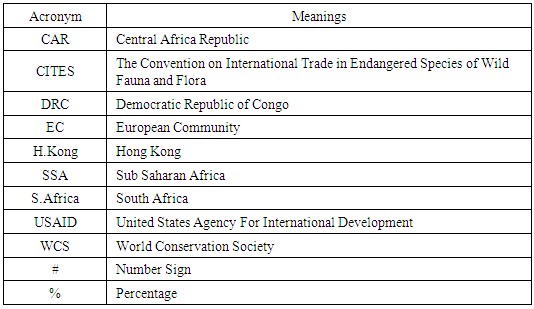
 Abstract
Abstract Reference
Reference Full-Text PDF
Full-Text PDF Full-text HTML
Full-text HTML